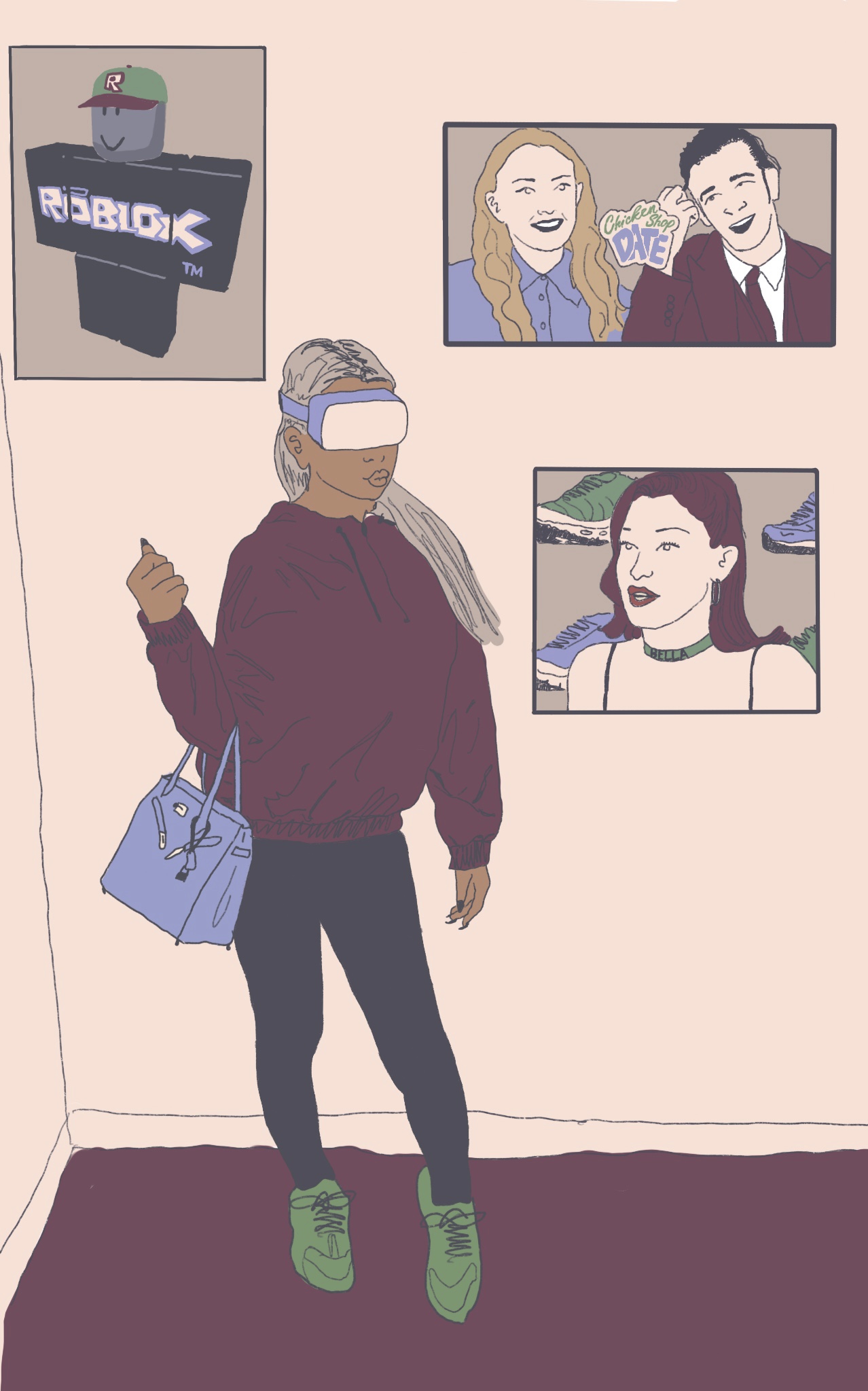Words: Maeve Gorman (she/her)
Artwork: Lewis Aitken (he/him)
This article features in our third print issue of the year, Ashes to Ashes.
Recently I have been hearing the phrase ‘That’s so meta’ everywhere. From indie boys at art shows to Chicken Shop Date (thanks Matty Healy), it’s a very current buzzword. ‘Meta’ is something that is self-referential, and shows ‘awareness of itself or its genre’. The 21st face of ‘meta’ is the metaverse: “A (hypothetical) virtual reality environment in which users interact with one another’s avatars and their surroundings in an immersive way’. The metaverse offers non-fungible tokens (NFTs) which are units of data certifying a digital asset and traded using cryptocurrency (that’s my tech knowledge exhausted).
The fashion industry is never one to be left behind, with brands including Dolce & Gabbana, Nike and Zara having already established a presence in the metaverse. But what exactly does the metaverse mean for the fashion world?
Enter Meta Birkins. In November 2021 Artist and NFT creator Mason Rothschild created digital renderings of the iconic Hermes Birkin bag (which can sell for anywhere between $10,000 and $2 million) and sold over $1 million worth of NFTs. Hermes sued for trademark infringement. At the beginning of February in a case that established if trademarks could hold up in the metaverse, a jury awarded Hermes $133,000 in damages. Rothschild reacted to the verdict stating, ‘I’m not creating or selling fake Birkin bags. I’m creating artworks that depict imaginary, fur-covered Birkin bags’. This use of fur imbues the work with a critique of the animal cruelty endemic in the production of the classic leather bag. Rothschild’s virtual work didn’t have quite the same environmental impact.
This whole saga raises important questions about the future of fashion. Could the metaverse solve problems of sustainability in fashion? Could it break down the access barriers to an exclusive world for up-and-coming designers? And most importantly, what could it mean for our own self-expression?
First, a run-down of fashion history in the metaverse. In 2018, AI influencers like Lil Miquela burst on to the scene giving us a glimpse of what was to come. John Galliano’s 2018 Margiela shows featured models wearing headphones and with phones strapped to their ankles, a precursor of the fashion x metaverse collab. With the COVID-19 pandemic, everything rapidly accelerated. Virtual fitting rooms were launched by Gucci and Louis Vuitton, and in 2021 Balenciaga (circa its relevant days) collaborated with Fortnite TO. In March 2022, Decentraland (a 3D virtual platform) launched the first Metaverse Fashion Week, and it’s making a return this year.
No 21st century fashion story would be complete without a cameo from fashion’s favourite nepo-baby, Bella Hadid. In May 2022, she launched an NFT platform, CY-B3LLA, which includes 11,111 NFTs of Bella herself. Hadid knows what she’s doing when it comes to fashion, and her involvement signals that she believes the metaverse is the next big thing. Even if you don’t subscribe to the prophecies of Hadid, investment bank Morgan Stanley predicts that the virtual fashion industry could be worth more than $55 billion by 2030 (honestly, what is going on?).
At first, to me, this whole thing seems a bit silly, intangible, and dystopian. I was quick to dismiss it. But the metaverse holds the potential to make real and positive change to the fashion world. Fashion is an industry with a well-documented environmental impact. The metaverse could help reduce waste as brands could test trial products on their virtual platforms and see the response before rolling them out in a mass, physical form.
The fashion and metaverse story has a human side too. Ukrainian designers, Bevza, Gudu and Ienki Ienki all showcased their work at Paris Fashion Week (Spring/Summer 2022) and the garments were later made available through an NFT marketplace. When their manufacturing and creative process was disrupted by the outbreak of war, the metaverse allowed for adaptation. Without materials, access, and art school, the metaverse provides a space for unbounded creativity and design.
The metaverse, too, can be a place of joy, freedom, and self-expression. Last year, three drag artists Tia Kofi, Blu Hydrangea and Adam All, collaborated with three designers to present ‘Queens of the Metaverse’, a metaverse drag show. The looks were accessed using one of Meta’s headsets. In an interview with Dazed, Tia Kofi stated, ‘As queer people, it’s really important for us to occupy these spaces…The Metaverse is literally pointing towards the future! It’s our time.’ Queer visibility, expression and freedom becomes just as important in the metaverse as in our social reality. It offers an outlet for this limitless, beautiful queer expression.
So, I am a begrudging convert to the idea of meta fashion becoming more mainstream. It’s not all NFTs, crypto and billionaires. It offers a genuine creative and expressive space. I’m not going to get Roblox yet, but I am excited for what is to come.
Sources:
https://www.oed.com/search?searchType=dictionary&q=meta+&_searchBtn=Search Oxford English Dictionary entry for “meta”.
https://www.oed.com/view/Entry/271922?redirectedFrom=metaverse+#eid Oxford English Dictionary entry for “metaverse”.

